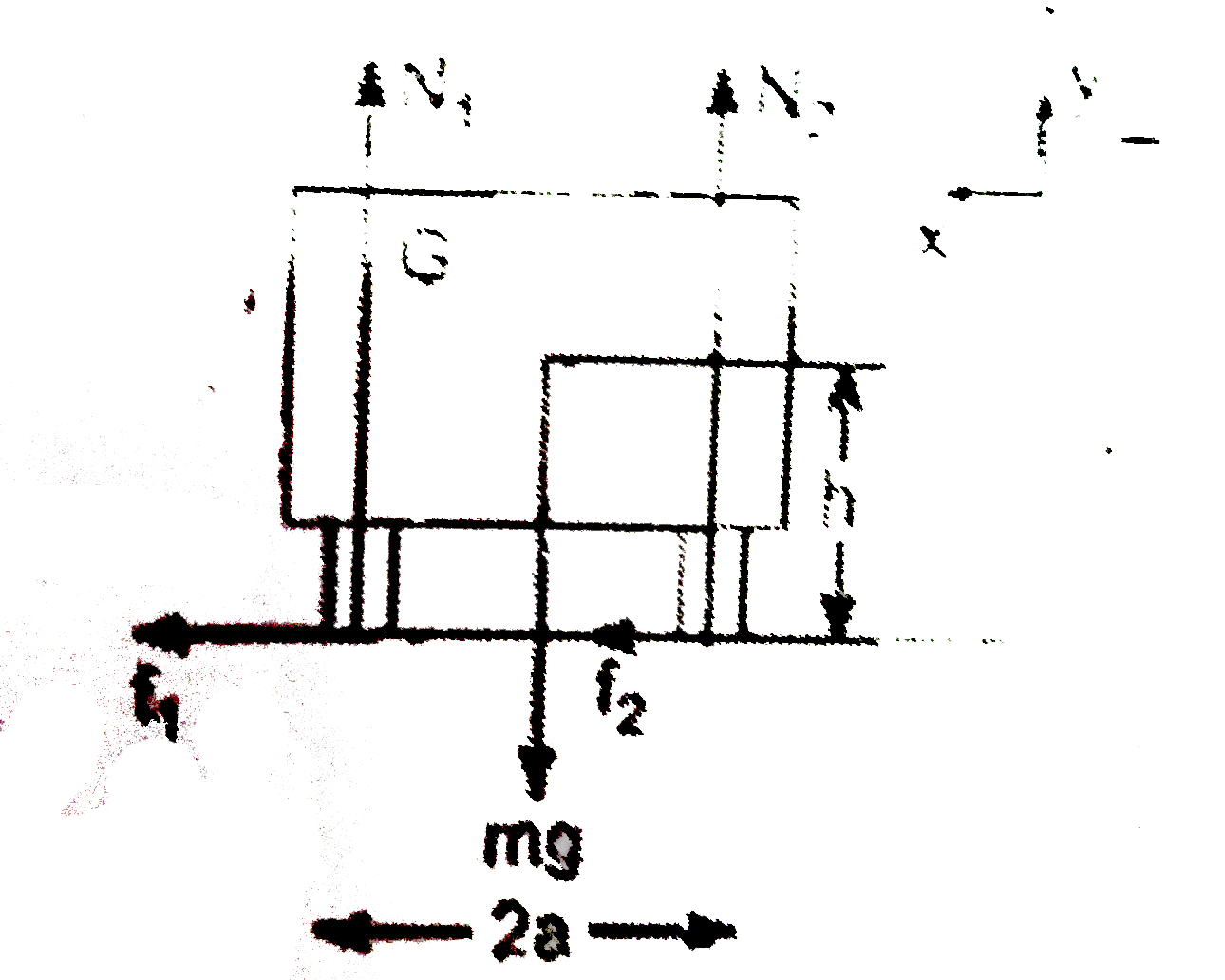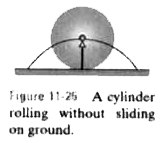Complete Solutions to SAMPLE PROBLEM of chapter RIGID BODY DYNAMICS-II of Class 12 book with complete answers and questions
| Class 12 | PHYSICS |
| Chapter | RIGID BODY DYNAMICS-II |
| RESNICK AND HALLIDAY | SAMPLE PROBLEM |
| Number Of Questions | 18 |
| Academic Year | 2023-24 |
The current land-speed record was set in the Black Rock Desert of Nevada in 1997 by the jet-powered car Thrust SSC. The car's speed was `1222 km//h` in one direction and `1233 km//h` in the opposite direction. Both speeds exceeded the speed of sound at that location (1207 km/h). Setting the land-speed record was obviously very dangerous for many reasons. One of them had to do with the car's wheels. Approximate each wheel on the car Thrust SSC as a disk of uniform thickness and mass M = 170 kg and assume smooth rolling. When the car's speed was 1233 km/h, what was the kinetic energy of each wheel?
View SolutionA uniform ball, of mass M = 6.00 kg and radius R, rolls smoothly from rest down a ramp at angle `theta = 30.0^(@)` .
(a) The ball descends a vertical height h = 1.20 m to reach the bottom of the ramp. What is its speed at the bottom?View SolutionA uniform ball, of mass M = 6.00 kg and radius R, rolls smoothly from rest down a ramp at angle `theta = 30.0^(@)` .
What are the magnitude and direction of the frictional force on the ball as it rolls down the ramp?03:43View SolutionA yo-yo has mass M = 0.550 kg and rotational inertia `I = 3.40 xx 10^(-4) kg m^(2)`?. It rolls from rest down a string of length L = 17.0 cm. What is its angular speed at the bottom?
View SolutionA yo-yo has mass M 0.550 kg, axle radius `R_(0) = 3.2 mm`, and rotational inertia `l = 3.4 xx 10^(-4) kg m^(2)` about its rotation axis. Assume that the string has negligible mass and thickness.
(a) What is the linear acceleration of the yo-yo as it rolls down the string from rest?02:26View SolutionA yo-yo has mass M 0.550 kg, axle radius `R_(0) = 3.2 mm`, and rotational inertia `l = 3.4 xx 10^(-4) kg m^(2)` about its rotation axis. Assume that the string has negligible mass and thickness.
What is the tension in the string as the yo-yo descends?02:45View SolutionA wheel rolls smoothly along a floor while being accelerating horizontally by a force `vecF_(n)` applied at its top. The wheel has radius R = 0.500 m, mass m = 1.60 kg, and acceleration magnitude `a = 2.00 m//s^(2)`. The frictional force on the wheel is in the forward direction and has magnitude f = 1.80 N. What is the rotational inertia of the wheel?
View SolutionA uniform hoop, disk, and sphere, with the same mass M and same radius R, are released simultaneously from rest at the top of a ramp of length L = 2.5 m and angle `theta = 12^(@)` with the horizontal. The objects roll smoothly down the ramp.
(a) Which object wins the race to the bottom of the ramp?08:47View SolutionA uniform hoop, disk, and sphere, with the same mass M and same radius R, are released simultaneously from rest at the top of a ramp of length L = 2.5 m and angle `theta = 12^(@)` with the horizontal. The objects roll smoothly down the ramp.
What is `v_("com")` for each object at the bottom of the ramp?05:50View SolutionKinetic energy distribution in a rolling object. Consider a hoop, a disk, and a sphere, each of mass M and radius R, that roll smoothly along a horizontal table. For each, what fraction of its kinetic energy is associated with the translation of its center of mass?
04:03View Solutiona uniform beam, of length L and mass m = 1.8 kg, is at rest on two scales. A uniform block, with mass M = 2.7 kg, is at rest on the beam, with its center a distance `L//4` from the beam's left end. What do the scales read?
06:03View SolutionFigure 11-16a shows a safe (mass M = 430 kg) hanging by a rope (negligible mass) from a boom (a = 1.9 m and b = 2.5 m) that consists of a uniform hinged beam (m=85 kg) and horizontal cable (negligible mass).
What is the tension `T_(c)` in the cable? In other words, what is the magnitude of the force `vecT_(c)` on the beam from the cable?View SolutionFigure 11-16a shows a safe (mass M = 430 kg) hanging by a rope (negligible mass) from a boom (a = 1.9 m and b = 2.5 m) that consists of a uniform hinged beam (m=85 kg) and horizontal cable (negligible mass).
Find the magnitude F of the net force on the beam from the hinge.04:28View Solutiona ladder of length L=12 m and mass m = 45 kg leans against a slick wall (that is, there is no friction between the ladder and the wall). The ladder's upper end is at height h = 9.3 m above the pavement on which the lower end is supported (the pavement is not frictionless). The ladder's center of mass is `L//3` from the lower end, along the length of the ladder. A firefighter of mass M = 72 kg climbs the ladder until her center of mass is `L//2` from the lower end. What then are the magnitudes of the forces on the ladder from the wall and the pavement?
07:34View SolutionLet's assume that the Tower of Pisa is a uniform hollow cylinder of radius R = 9.8 m and height h=60 m. The center of Mass is located at height `h//2`, along the cylinder's central axis. In Fig. 11-18a, the cylinder is upright. In Fig. 11-18b, it leans rightward (loward the tower's southern wall) by `theta= 5.5`, which shifts the com by a distance d. Let's assume that the ground exerts only two forces on the tower. A normal force `vecF_(NL)= 0` acts on the left (northern) wall, and a normal force we acts on the right (southern) wall. By what percent does the magnitude Far increase because of the leaning?
07:49View SolutionThe crate in Fig. 11-20 has dimensions I by h and the ramp is inclined at `theta` to the horizontal. Find the maximum `theta` for which it does not topple. Coefficient of friction between ramp and crate is `mu`.
06:51View SolutionA car of mass `m` travelling at speed `v` moves on a horizontal track. The centre of mass of the car describes a circle of radius `r`. If `2a` is the separation of the inner and outer wheels and `h` is the height of the centre of mass above the ground, show that the limiting speed beyond which the car will overturn in given by
`v^(2)=(gra)/h`
 07:05View Solution
07:05View SolutionA cylinder of radius r is rolling purely on ground, find out if the number of particles having velocity greater than v are more than those having velocity less than `v_(c)`
 View Solution
View Solution
SAMPLE PROBLEM questions and complete solutions for chapter RIGID BODY DYNAMICS-II of RESNICK AND HALLIDAY PHYSICS (HINGLISH) of Class 12
